#Muscogee Creek Nation
Explore tagged Tumblr posts
Text
https://x.com/VannMarilyn/status/1707533126702973306?t=Sj0McYkbpcg25tf6k9q08w&s=09

#Cherokee Nation#Freedmen#Black Freedmen#Marilyn Vann#Creek Nation#Muscogee#citizenship#tribal rights
1 note
·
View note
Photo


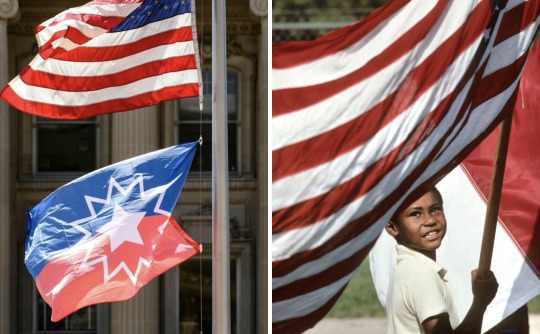


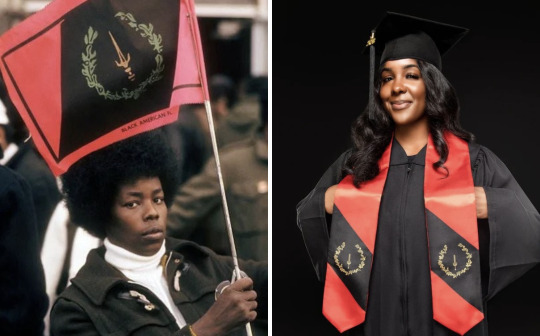
Juneteenth is a Black American holiday.
We call Juneteenth many things: Black Independence Day, Freedom Day, Emancipation Day, Jubilee Day. We celebrate and honor our ancestors.
December 31 is recognized as Watch Night or Freedom’s Eve in Black American churches because it marks the day our enslaved ancestors were awaiting news of their freedom going into 1863. On January 1, 1863, President Lincoln issued the Emancipation Proclamation. But all of the ancestors wouldn’t be freed until June 19, 1865 for those in Galveston, Texas and even January 23, 1866 for those in New Jersey (the last slave state). (It’s also worth noting that our people under the Choctaw and Chickasaw Nations wouldn’t be freed until April 28, 1866 and June 14, 1866 for those under the Cherokee Nation by way of the Treaties.)
Since 1866, Black Americans in Texas have been commemorating the emancipation of our people by way of reading the Emancipation Proclamation and coming together to have parades, free festivities, and later on pageants. Thereafter, it spread to select states as an annual day of commemoration of our people in our homeland.
Here’s a short silent video filmed during the 1925 Juneteenth celebration in Beaumont, Texas:
youtube
(It’s also worth noting that the Mascogos tribe in Coahuila, Mexico celebrate Juneteenth over there as well. Quick history lesson: A total of 305,326 Africans were shipped to the US to be enslaved alongside of American Indians who were already or would become enslaved as prisoners of war, as well as those who stayed behind refusing to leave and walk the Trail of Tears to Oklahoma. In the United States, you were either enslaved under the English territories, the Dutch, the French, the Spanish, or under the Nations of what would called the Five “Civilized” Native American Tribes: Cherokee, Creek (Muscogee), Chickasaw, Choctaw, and Seminoles. Mascogos descend from the Seminoles who escaped slavery during the Seminole Wars, or the Gullah Wars that lasted for more than 100 years if you will, and then settled at El Nacimiento in 1852.)
We largely wave our red, white and blue flags on Juneteenth. These are the only colors that represent Juneteenth. But sometimes you may see others wave our Black American Heritage flag (red, black, and gold).
Juneteenth is a day of respect. It has nothing to do with Africa, diversity, inclusion, immigration, your Pan-African flag, your cashapps, nor your commerce businesses. It is not a day of “what about” isms. It is not a day to tap into your inner colonizer and attempt to wipe out our existence. That is ethnocide and anti-Black American. If you can’t attend a Black American (centered) event that’s filled with education on the day, our music, our food and other centered activities because it’s not centered around yours…that is a you problem. Respect our day for what and whom it stands for in our homeland.
Juneteenth flag creator: “Boston Ben” Haith
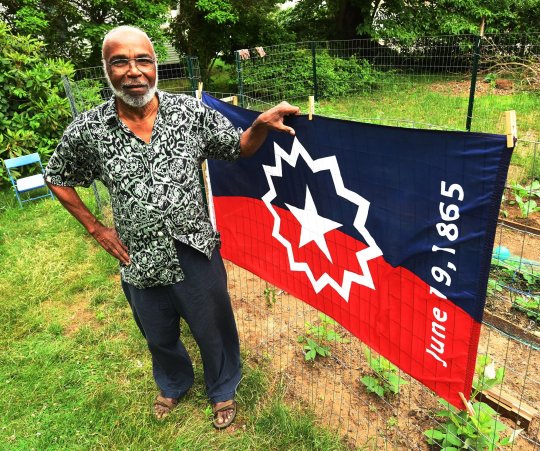
It was created in 1997. The red, white and blue colors represent the American flag. The five-point star represents the Lone State (Texas). The white burst around the star represents a nova, the beginning of a new star. The new beginning for Black Americans.
Black American Heritage Flag creators: Melvin Charles & Gleason T. Jackson

It was created in 1967, our Civil Rights era. The color black represents the ethnic pride for who we are. Red represents the blood shed for freedom, equality, justice and human dignity. Gold fig wreath represents intellect, prosperity, and peace. The sword represents the strength and authority exhibited by a Black culture that made many contributions to the world in mathematics, art, medicine, and physical science, heralding the contributions that Black Americans would make in these and other fields.

SN: While we’re talking about flags, I should note that Grace Wisher, a 13-year-old free Black girl from Baltimore helped stitched the Star Spangled flag, which would inspire the national anthem during her six years of service to Mary Pickersgill. I ain’t even gon hold you. I never looked too far into it, but she prob sewed that whole American flag her damn self. They love lying about history here until you start unearthing them old documents.
In conclusion, Juneteenth is a Black American holiday. Respect us and our ancestors.
#juneteenth#juneteenth flag#black american history#black american culture#ben haith#black american heritage flag#melvin charles#gleason t jackson#grace wisher#american flag#mascogos#juneteenth 2023
1K notes
·
View notes
Text













Voices of the Land
What better way to celebrate Indigenous Peoples’ Day than to highlight this landmark anthology that commemorates the Indigenous Peoples of North America? When the Light of the World was Subdued, Our Songs Came Through: A Norton Anthology of Native Nations Poetry, edited by Joy Harjo with Leanne Howe, Jennifer Elise Foerster, is a curated collection that features the poetry of 160 poets each showcasing a distinct voice from nearly 100 Indigenous Nations. This is the first edition from 2020, published by W. W. Norton & Company in New York.
The anthology is the first to provide a historically comprehensive collection of Native poetry. The literary traditions of Native Americans, the original poets of this country, date back centuries. The book opens with a blessing from Pulitzer Prize winner American Kiowa/Cherokee N. Scott Momaday (1934-2024) and contains introductions from contributing editors for five geographically organized sections. Each section begins with a poem from traditional oral literature and closes with emerging poets, creating a rich and diverse tapestry of Indigenous voices.
Joy Harjo, a member of the Muscogee (Creek) Nation, is a prominent figure in the literary world. She is known for her work as a poet, musician, playwright, and author. In addition to her contributions to literature, Harjo is also a celebrated performer and has released several albums combining poetry and music. In 2019, she made history by becoming the first Native American United States Poet Laureate and only the second to serve three terms. Throughout her career, Harjo has been a vocal advocate for Indigenous rights and has used her art to shed light on the experiences of Native peoples.
The following is an excerpt from Harjo’s introduction to this work:
“The anthology then is a way to pass on the poetry that has emerged from rich traditions of the very diverse cultures of indigenous peoples from these indigenous lands, to share it. Most readers will have no idea that there is or was a single Native poet, let alone the number included in this anthology. Our existence as sentient human beings in the establishment of this country was denied. Our presence is still an afterthought, and fraught with tension, because our continued presence means that the mythic storyline of the founding of this country is inaccurate. The United States is a very young country and has been in existence for only a few hundred years. Indigenous peoples have been here for thousands upon thousands of years and we are still here.”
View other Indigenous Peoples' Day posts.
View other posts from our Native American Literature Collection.
-Melissa (Stockbridge-Munsee), Special Collections Graduate Intern
We acknowledge that in Milwaukee we live and work on traditional Potawatomi, Ho-Chunk, and Menominee homelands along the southwest shores of Michigami, part of North America’s largest system of freshwater lakes, where the Milwaukee, Menominee, and Kinnickinnic rivers meet and the people of Wisconsin’s sovereign Anishinaabe, Ho-Chunk, Menominee, Oneida, and Mohican nations remain present.
#indigenous peoples' day#When the Light of the World was Subdued#Our Songs Came Through#joy harjo#Leanne Howe#Jennifer Elise Foerster#W. W. Norton & Company#N. Scott Momaday#first nations#native americans#Native poetry#indigenous literature#indigenous poetry#poetry anthology#poet laureate
75 notes
·
View notes
Text

Sarah Deer
Gender: Female
Sexuality: Queer
DOB: 9 November 1972
Ethnicity: Native American (Muscogee (Creek) Nation)
Occupation: Lawyer, professor, activist
#Sarah Deer#lgbt#lgbtq#queerness#lgbt people#female#queer#1972#native#native american#poc#teacher#lawyer#activist
54 notes
·
View notes
Text
Check their shoes and look for mud!” shouted one Atlanta police department officer to another. The sun was setting against a tree line growing greener daily due to recent balmy, spring-like weather in Atlanta, but the bucolic setting of a Sunday in the sun at a free music festival abruptly became panic and chaos. Dozens of law enforcement officers, many with automatic weapons, swarmed into a forest of hundreds of acres, seeking to find any of the 200 or so activists who had set fire to a bulldozer, trailer and other infrastructure used for construction on “Cop City”, a $90m, 85-acre police and fire department training center, about an hour earlier. The clash was just the latest dramatic chapter to hit the Cop City project, which has already seen one environmental activist shot dead by police – the first incident of its kind in the US – and drawn national and international attention to the fight to save the Georgia forest where the giant project is planned. The one officer’s frenzied order about dirty footwear seemed as absurd as any part of the Sunday night operation, since Georgia rains had left muddy patches all over the forest, and at least 600 people were lying on the grass, or camped among the trees, or entering the forest to catch an evening’s music under the stars or leaving – thus many had mud on their shoes. But such was the situation on Sunday night, on the second night of the fifth “week of action” by activists over the last year dedicated to protecting the land called South River forest on municipal maps and Weelaunee forest by activists – using the Muscogee (Creek) word for “brown water”. The scene included police running through trees, arresting a legal observer from the National Lawyers Guild, sending a negotiator to agree on terms with five randomly chosen individuals for letting about a hundred music festival audience members safely leave the forest, and detaining journalists for questioning on “what they were there to cover”. The first two days had included free music, herbal workshops and a peaceful march through neighborhoods surrounding the forest south-east of Atlanta. Then, around 5.30 on Sunday evening, about 200 activists, most in balaclavas and camouflage clothing, began lining up to the right of the stage. They marched around three sides of the audience, chanting “Viva Tortuguita” – a reference to Manuel Paez Terán, a 26-year-old activist who was camping several hundred feet away from that spot on 18 January when police shot and killed him in another raid. It was the first time police killed an environmental activist while protesting in US history. Authorities said that Paez Terán fired first. After several hours of chaos on Sunday night, 23 people – including a legal observer with the National Lawyers Guild – had been arrested and charged with “domestic terrorism” under state law, adding to the 18 defendants facing the same unprecedented charges who have been arrested in recent months.
407 notes
·
View notes
Text
Shannen's Native American Descent
We all know Shannen Doherty was of Irish descent through the paternal side of her family.
The Doherty / O’Doherty family is an Irish clan based in County Donegal. The O’Dohertys are named after Dochartach (c. 10th century), a member of the Cenél Conaill dynasty which in medieval Irish genealogy traced itself to Niall of the Nine Hostages. The O’Doherty clan and family name is one of the most ancient in Europe. The clan traces its pedigree through history, pre-history, and mythology to 2BC. (Source)
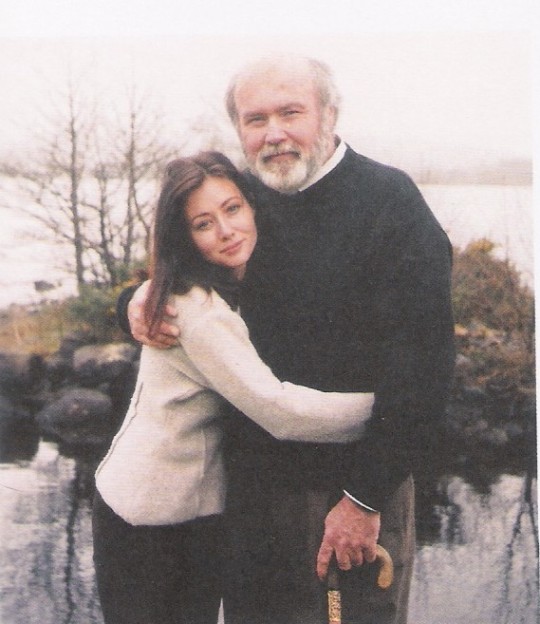
Shannen and her dad, John Thomas Doherty, in Ireland ca. 1996/97.
Shannen was also from English and Scottish descent through her mother Rosa Elizabeth née Wright. The red-haired Southern belle also has Native American ancestry, most concretley the Chumash people (Source), and thus has Shannen (Source).
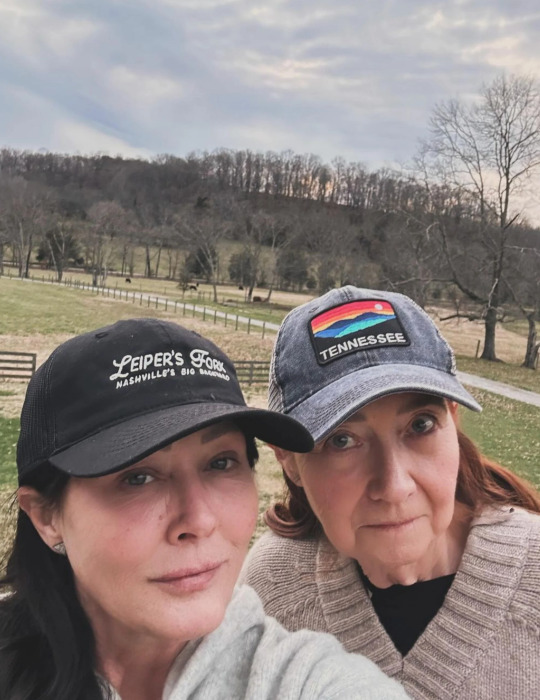
Shannen and her mum spending time in nature, ca.2024.
Shannen explained that she wasn't able to be with her dad when he passed away on the 4th of November of 2010. Her best friend Chris Cortazzo told her to spend some quality time with her mother and him at his ranch in Tennesse, which is surrounded by Native American ground. When she was there suddenly the wind shaked the plants and trees and she felt her father’s arms go around her and say “It’s ok baby, I love you. I’m here" (Source) (Source).
Her mother Rosa said that one of her great-great-grandmothers (she doesn't know the grade) was forced to move in the called "Trail of Tears", the forced displacement of approximately 60,000 people of the "Five Civilized Tribes" [Cherokee, Chickasaw, Choctaw, Muscogee (Creek), and Seminoles] between 1830 and 1850, and the additional thousands of Native Americans within that were ethnically cleansed by the United States government (Wiki). Furthermore, she said her ancestor was from the Chumash people and was forced to move from Mississipi to Oklahoma (Source).
Rosa also said about Shannen's Native American's heritage:
"The whole Indian heritage to Shannen was very, very important ... Shannen swore when she bought this property [a ranch in Malibu to live with her mum, her friends, and to do a shelter for horses]… she says, I just feel it. She says, I know that this is where I'm supposed to be. And she just felt that whole Indian."
Also she was proud of having directed "Charmed"'s episode "The Good, The Bad and The Cursed" that features a storyline involving American's First Nations people's and Native actors Kimberly Guerrero (from Colville and Salish-Kootenai native peoples from Alaska) and Michael Greyeyes (Nêhiyaw (Plains Cree) from Muskeg Lake Cree Nation in Saskatchewan, Canada).
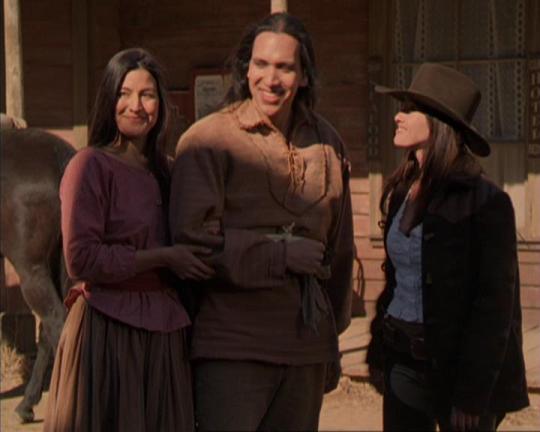
Shannen Doherty (R) with First Nations' actors Kimberley Guerrero and Michael Greyeyes.
The Chumash are a Native American people of the central and southern coastal regions of California (Wiki), in portions of what is now Kern, San Luis Obispo, Santa Barbara, Ventura and Los Angeles counties, extending from Morro Bay in the north to Malibu in the south to Mt Pinos in the east. Their territory includes three of the Channel Islands: Santa Cruz, Santa Rosa, and San Miguel; the smaller island of Anacapa was likely inhabited seasonally due to the lack of a consistent water source.
Modern place names with Chumash origins include Malibu, Nipomo, Lompoc, Ojai, Pismo Beach, Point Mugu, Port Hueneme, Piru, Lake Castaic, Saticoy, Simi Valley and Somis. Archaeological research demonstrates that the Chumash people have deep roots in the Santa Barbara Channel area and lived along the southern California coast for millennia.
The Chumash lived in over 150 independent villages, speaking variations of the same language. Much of their culture consisted of basketry, bead manufacturing and trading, cuisine of local abalone and clam, herbalism which consisted of using local herbs to produce teas and medical reliefs, rock art, and the scorpion tree. The scorpion tree was significant to the Chumash as shown in its arborglyph: a carving depicting a six-legged creature with a headdress including a crown and two spheres. The shamans participated in the carving which was used in observations of the stars and in part of the Chumash calendar. The Chumash resided between the Santa Ynez Mountains and the California coasts where a bounty of resources could be found. The tribe lived in an area of three environments: the interior, the coast, and the Northern Channel Islands. Some researchers believe that the Chumash may have been visited by Polynesians between AD 400 and 800, nearly 1,000 years before Christopher Columbus reached the Americas.
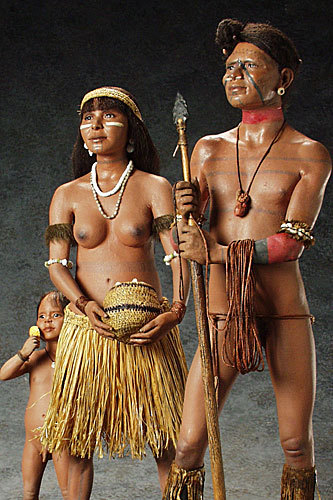
Chumash Family by American sculptor George S. Stuart
The maritime explorer Juan Cabrillo was the first European to make contact with the coastal Alta Californian tribes in the year 1542. Spain claimed what is now California from that time forward, but did not return to settle until 1769, when the first Spanish soldiers and missionaries arrived with the double purpose of Christianizing the Native Americans and facilitating Spanish colonization. The Chumash people moved from their villages to the Franciscan missions between 1772 and 1817.
Mexico seized control of the missions in 1834. Tribespeople either fled into the interior, attempted farming for themselves and were driven off the land, or were enslaved by the new administrators. After 1849 most Chumash land was lost due to theft by Americans and a declining population, due to the effects of violence and disease. The remaining Chumash began to lose their cohesive identity. In 1855, a small piece of land (120 acres) was set aside for just over 100 remaining Chumash Indians near Santa Ynez mission. This land ultimately became the only Chumash reservation, although Chumash individuals and families also continued to live throughout their former territory in southern California.
No native Chumash speak their own language since Mary Yee, the last Barbareño speaker, died in 1965. Today, the Chumash are estimated to have a population of 5,000 members.
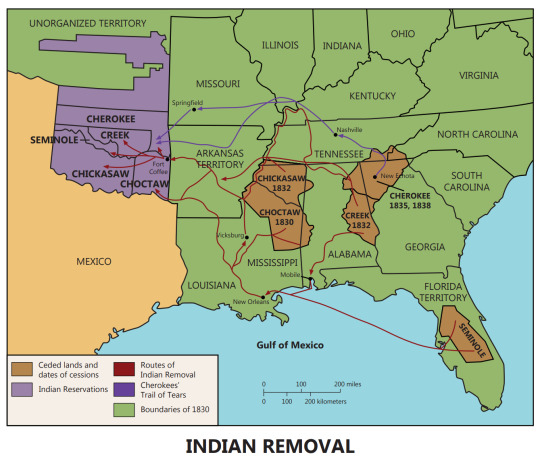
Map of the Trail of Tears
Chumash worldview is centered on the belief "that considers all things to be, in varying measure, alive, intelligent, dangerous, and sacred." "They assume that the universe with its three, or in some versions five, layers has always been here."
Human beings occupy the Middle Region, which rests upon two giant snakes. Chronological time is unimportant, though the past is divided into two sections: the universal flood that caused the First People to become the natural world and, thereafter the creation of human beings, the arrival of the Europeans, and the devastating consequences that followed."
The middle region (sometimes referred to as 'antap), where humans and spirits of this world live and where shamans could travel in vision quests, is interconnected with the lower world (C'oyinahsup) through the springs and marsh areas and is connected to the upper world through the mountains. In the lower world live snakes, frogs, salamanders. The world trembles or has earthquakes when the snakes which support the world writhe.
Water creatures are also in contact with the powers of the lower world and "were often depicted in rock art perhaps to bring more water to the Chumash or to appease underworld spirits' at times of hunger or disease." Itiashap is the home of the First People. Alapay is the upper world in Chumash cosmology where the "sky people" lived, who play an important role in the health of the people. Principle figures of the sky world include the Sun, the Moon, Lizard, Sky Coyote, and Eagle. The Sun is the source of life and is also "a source of disease and death." The Sky Coyote, also known as the Great Coyote of the Sky or Shnilemun, is considered to be a protector and according to Inseño Chumash lore, “looks out for the welfare of all in the world below him”. During the creation of mankind, the Sky Coyote was present among the other important cosmological figures. The Eagle, also known as Slo’w, is the force that maintains momentum and order among the other stars so that they do not fall down on and destroy earth.
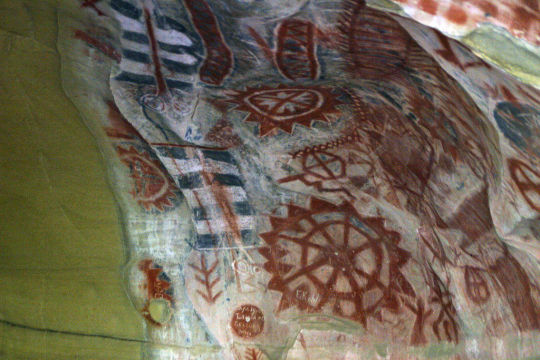
Chumash pictographs.
The Chumash cosmology is also centered around astronomy. Rock art and arborglyphs that have been found within Chumash sites are thought to have depicted Polaris (the North Star) and Ursa Major (the Big Dipper). These two astrological entities were paramount to the Chumash belief system as well as their perception of time. It is believed that the Chumash used these constellations to determine what time of the year it was depending on the position of Ursa Major around Polaris.
***
I love that Shannen showed her respect to her ancestry in some "Charmed" episodes, like in 2x10 "Heartbreak City" (click to see if bigger):

Charmed 3x01 "The Honeymoon is Over" (click to see bigger):

And the already mentioned 3x14 "The Good, The Bad and The Cursed" (click to see bigger). Her love for horses also comes from that connection:

#shannen doherty#ancestry#irish ancestry#native american ancestry#first nations ancestry#chumash#chumash people#family#trail of tears#heritage#indian heritage#charmed 3x14#charmed 2x10#charmed 3x01#charmed#director#shannen doherty director#shannen director#1990s shannen doherty#2000s shannen doherty#2020s shannen doherty#rosa doherty#malibu#chris cortazzo#tennesse
21 notes
·
View notes
Text
In January 2023, ProPublica has published a new and detailed report on the failure of United States museums and universities to repatriate human remains of Indigenous peoples, even when required by law.
Just ten institutions “hold about half of the Native American remains that have not been returned to tribes” as required by the 1990 law Native American Graves Protection and Repatriation Act. As of December 2022, about “200 institutions [...] had repatriated none of the remains of more than 14,000 Native Americans in their collections.” ProPublica has investigated whether or not these institutions have complied with the 1990 law, and, in their opening paragraphs, they have “found that a small group of institutions and government bodies has played an outsized role in the law’s failure.”
By the 1870s, as the academic field of archaeology soared in popularity, some of the most prestigious institutions in the US were relying on the US military to extract Indigenous items for their collections. For example, “the Smithsonian Institution struck a deal with U.S. Army Gen. William Tecumseh Sherman to pay each of his soldiers up to $500 — or roughly $14,000 in 2022 dollars — for items such as clothing, weapons and everyday tools sent back to Washington.”
Meanwhile: “Frederic Ward Putnam, who was appointed curator of Harvard University’s Peabody Museum of American Archaeology and Ethnology in 1875, commissioned and funded excavations that would become some of the earliest collections at Harvard, the American Museum of Natural History and the Field Museum. He also helped establish the anthropology department and museum at UC Berkeley — which holds more human remains taken from Native American gravesites than any other U.S. institution that must comply with NAGPRA.”
By the beginning of the 20th century, local museums in the Midwest and Southeast (Illinois, Ohio, Kentucky, and Tennessee) were obsessed with acquiring “moundbuilders” artifacts and initiated another wave of extraction. For example, most of the collections of the University of Kentucky’s William S. Webb Museum of Anthropology were taken during excavations funded by the federal government in the 1930s as part of the New Deal’s job-creation program, and although more than 80% of the museum’s holdings are “subject to return under federal law,” the museum “has yet to repatriate any of the roughly 4,500 human remains it has reported to the federal government.”
While the “Smithsonian Institution today holds in storage the remains of roughly 10,000 people, more than any other U.S. museum,” the Smithsonian actually “reports its repatriation progress under a different law” and therefore “does not publicly share information about what it has yet to repatriate with the same detail.”
According to ProPublica’s analysis, a major excuse given by institutions is that their collections are “culturally unidentifiable.” They report that “many institutions have interpreted” the words cultural affiliation “so narrowly that they’ve been able to dismiss” tribes’ claims. In other words, these museums claim that, because they cannot reliably trace a lineage between the original source of the remains and contemporary recognized tribes, they therefore cannot return remains. In this way, ProPublica says, that “[t]hroughout the 1990s, institutions including the Ohio History Connection and the University of Tennessee, Knoxville thrawted the repatriation process by categorizing everything” as “culturally unidentifiable.”
However, many tribes and their advocates claim this is a silly excuse. For example, the “University of Alabama Museums is among the institutions that have forced tribes into lengthy disputes over repatriation.” And tribes “had tried for more than a decade to repatriate Moundville ancestors.” By “October 2021, leaders from the Choctaw Nation of Oklahoma, Chickasaw Nation, Muscogee (Creek) Nation, Seminole Nation of Oklahoma, and the Seminole Tribe of Florida brought the issue to the federal NAGPRA Review Committee” and the “tribes eventually forced the largest repatriation in NAGPRA’s history” when “the university agreed to return the remains of 10,245 ancestors.”
Quoted excerpts above, and all graphics and excerpts below, from the report:
Logn Jaffe, Mary Hudetz, Ash Ngu, and Graham Lee Brewer. “America’s Biggest Museums Fail to Return Native American Human Remains.” ProPublica. 11 January 2023. (Illustrations by Weshoyot Alvitre for ProPublica. Design and development by Anna Donlan. Asia Fields and Brooke Stephenson contributed reporting.)
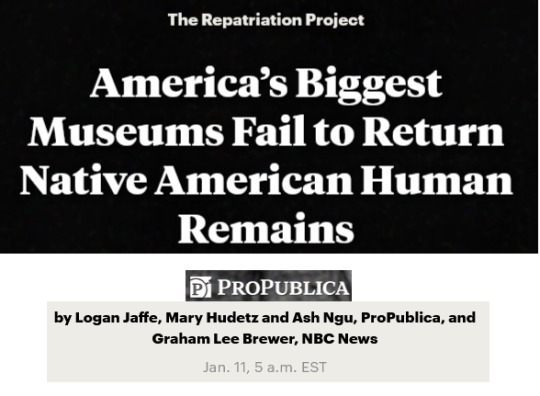
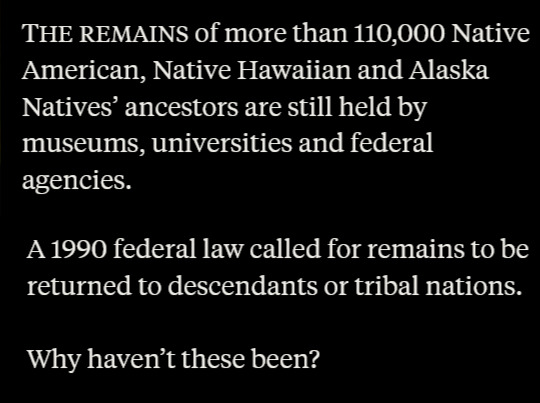



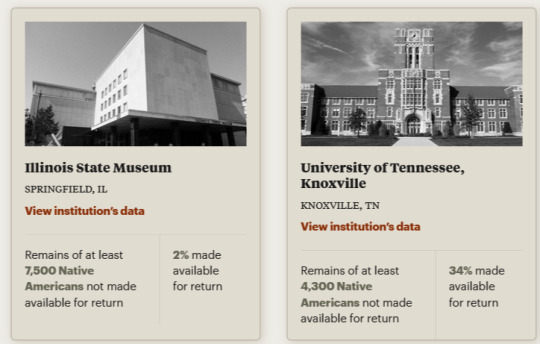





505 notes
·
View notes
Text
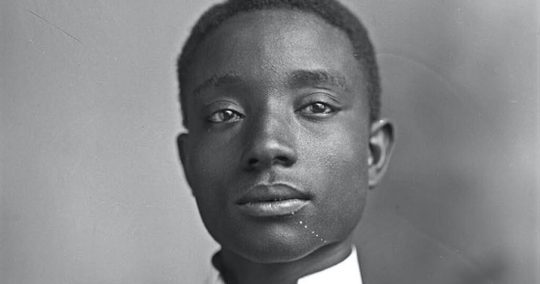
Freedmen Seek Their Fair Share of Billions of Dollars in Federal Aid and Why We Should Care/Rise UP and Support Them
By Eli Grayson Eagle Guest Writer
Eli Grayson is a Creek Citizen and unabashed supporter of the Freedmen descendants of the 5 Civilized Tribes and the 1866 Reconstruction Treaties.
This past week, we celebrated our Nation’s 244th year of Independence with family and friends over BBQ and fireworks, we should all stop to reflect on its significance, particularly in light of the Black Lives Matter (BLM) movement.
The protests that have swept the country by those outraged over the death of George Floyd, Breonna Taylor, Ahmaud Arbery, and far too many others, most of whose names have not garnered national attention, has sparked a long-overdue National dialogue about the treatment of Black Americans in the United States, a reckoning with this country’s past, the many vestiges of slavery that continue today, and what we as a country can and must do to address racism. [It also reminds ALL of us that we have a long way to go.]
Not only have the egregious deaths of George Floyd, Breonna Taylor, and Ahmaud Arbery led to a growing chorus of voices calling for criminal justice reform, it has prompted many to reflect upon racism in both its subtle and overt forms today. It has prompted many to learn about events long celebrated by Black Americans such as Juneteenth (even the NFL recently recognized Juneteenth as an official holiday). And it has prompted many to consider what steps we as individuals, and as a society, can take to affirmatively address it. Here in Oklahoma, attention has focused on Black Wall Street and the 1921 Tulsa Race Massacre.
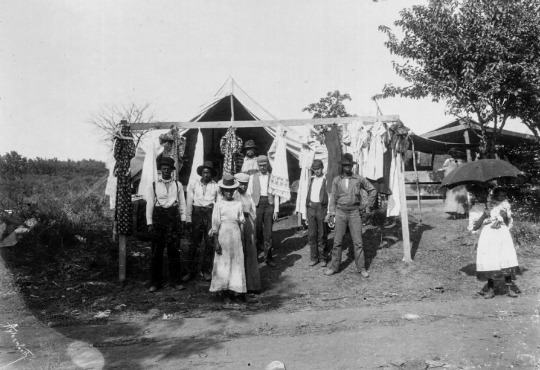
Well known is the U.S. Government’s abhorrent treatment of Native Americans, which included abrogation of countless treaties, appropriation of land, and forced removal to Western territories, including what is today Oklahoma.
Less well known, however, is the fact that the Cherokee, Chickasaw, Choctaw, Muscogee (Creek) and Seminole Nations – collectively known today as the Five Civilized Tribes – enslaved Africans. Like Southern plantation owners, they bought and sold slaves and treated them as chattel property. Indeed, slaveholding was such an integral part of the daily life of these tribal nations that each entered treaties with the Confederate States of America in 1861 to ensure its continuance.
Many Americans recently learned for the first time about the meaning and significance of Juneteenth, when nearly all remaining slaves in the United States and its territories were freed – a full 71 days after Confederate General Robert E. Lee surrendered at Appomattox on April 9, 1865 to Union forces led by General Ulysses S. Grant.
Enslaved Africans of Indian Territory
This was not the case for the enslaved Africans of Indian Territory. Even after Lee’s surrender, and even after General Granger read his Orders, the enslaved Africans of Indian Territory were kept in bondage.
Sadly, it was not until the Five Tribes of Indian Territory entered Treaties with the U.S. Government on March 21, with the Seminole Nation, on April 28, with the Chickasaw and Choctaw Nations, on June 14, with the Muscogee (Creek) Nation and on July 19, with the Cherokee Nation in 1866 – more than a year after Lee’s surrender – were these slaves granted freedom, tribal citizenship, and equal interest in the soil and national funds.
Each of these treaties (collectively known as the Treaties of 1866) contained provisions freeing the slaves and an express acknowledgement that the U.S. Constitution was, and shall remain, the Supreme Law of the land. Notably, there was no mention of tribal law or sovereignty insulating these slave holding tribes from full compliance with the U.S. Constitution, which includes all the Civil War reconstruction amendments.
Today, we find ourselves at a turning point in society. Similar to the country as a whole, the Cherokee, Chickasaw, Choctaw, Muscogee (Creek), and Seminole Nations must take this seminal moment to carefully examine their slaveholding past, their prior allegiance with the Confederacy, enshrined through Treaties entered in 1861, and how they can make amends by fully adhering to both the letter and spirit of the 1866 Reconstruction Peace Treaties.
Congressional legislation
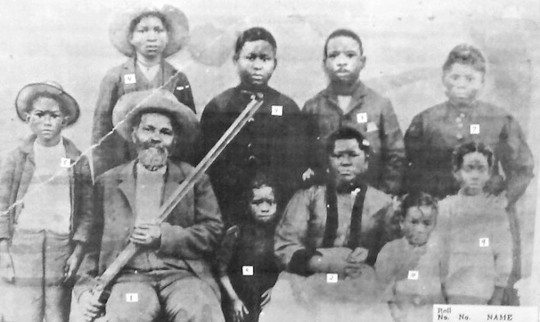
The three House bills are H.R. 2, the Invest in America Act, which includes $1 billion for the Native American Housing Block Grant Program to create or rehabilitate over 8,000 affordable homes for Native Americans on tribal lands; H.R. 6800, the HEROES Act, which includes $6 billion for housing and community development to respond to the Coronavirus; and H.R. 5319, the Native American Housing and Self-Determination Reauthorization Act (NAHASDA), which would authorize $680 million in grants to tribes in the first year and grow to $824 million in the fifth and final year.
Why is this important and why should you care? NAHASDA was originally passed by Congress in 1996 to address poor housing conditions in Indian country and last re-authorized in 2008. It is a flagship Federal law for Native American tribes and the vehicle through which approximately $650 million flows annually to the tribes. In Oklahoma, the Five Civilized Tribes receive more than $62 million annually in direct grants for housing and community development projects. These grants are based on a formula that takes into account various factors including the number of tribal members. Notably, these grants are supported by taxpayers.
For the 2021 Fiscal Year, the U.S. Department of Housing and Urban Development (HUD), which is responsible for administering NAHASDA, has informed the Five Civilized Tribes that they can expect to receive $62,223,462. Thus, nearly 10 percent of all NAHASDA grant funds will go to just these five tribes. By any measure, this is a significant sum, particularly when you consider that there are approximately 573 federally recognized tribes in the United States today, according to data from the federal Bureau of Indian Affairs. And, the final amount will be even greater as Congress has (appropriately) increased the amount of funds for NAHASDA far above the amounts requested by this Administration, including an appropriation of $825 million for this Fiscal Year.
Oklahoma Tribes receive millions in housing aid
Native American Tribes also receive other competitively awarded grants from HUD through a program known as the Indian Community Development Block Grant program. The Choctaw Nation was recently awarded $900,000 to rehabilitate 60 single-family homes while the Cherokee Nation received the same sum to construct a community building, which will house the Early Head Start program. The Chickasaw Nation was awarded $900,000 to construct a youth center in Ardmore, Oklahoma that will provide a safe and clean place for activities and services for Chickasaw tribal youth while the Muscogee (Creek) Nation will use its $900,000 award to construct a facility on the campus of the College of Muscogee Nation. The facility will include space for exhibitions and a lecture hall. These are worthy projects and it is vital that all those in need, including Freedmen descendants, can benefit.
Why Freedmen are concerned
Now if you have read this far, you must be thinking this is great news for these five tribes. And indeed, it is. However, for the Freedmen who are de facto members of the tribe, they may never see a dime of these funds if history is any guide.
Steps such as conditioning or denying the issuance of Citizenship Cards to Freedmen descendants, as well the disenrollment of Freedmen as tribal citizens, is what first led Congress in 2008 to include language in the NAHASDA re-authorization bill to link the receipt of NAHASDA housing grants to compliance with the treaty rights and benefits conferred on the Freedmen through the 1866 treaties.
That is why the efforts of House Financial Services Committee Chairwoman Maxine Waters, D-California, to fight on behalf of the Freedmen of all Five Civilized Tribes is so vital.
The committee she chairs oversees HUD and is responsible for periodically re-authorizing NAHASDA. A bi-partisan bill introduced in Congress last December would re-authorize NAHASDA. However, unlike the 2008 legislation, which contained language to prevent the Cherokee Nation from denying Cherokee Freedmen under the Act, the bill introduced by Rep. Denny Heck and co-sponsored by Reps. Scott Tipton (R-Colorado), Ben Ray Lujan (D-New Mexico), Tom Cole (R-Oklahoma), Deb Haaland (D- New Mexico), Don Young (R-Arkansas), Rep. Gwen Moore (D-Wisconsin), and Rep. Tulsi Gabbard (D-Hawaii), does not contain any protections for the Cherokee Freedmen nor the Freedmen of the other Civilized Tribes. Similarly, the version introduced in the Senate last week is devoid of such protections for the Freedmen.
Disturbed by the pattern of denying benefits to Freedmen, Chairwoman Waters is seeking assurance that descendants of Freedmen are not denied NAHASDA funds received by the Tribes. The Descendants of the Freedmen of the Five Civilized Tribes have been working to include language that would ensure that the Freedmen of all Five Civilized Tribes receive taxpayer funded NAHASDA benefits. A similar effort advanced by former House Financial Services Committee Chairman Barney Frank was successful and helped to ensure that Cherokee Freedmen received NAHASDA benefits. And in case, any question whether such protections were needed, one look only to the fact that HUD held up NAHASDA funds to the Cherokee Nation for noncompliance.
Native Americans keep fight against Freedmen
Given the harsh treatment of Native Americans at the hands of whites, one naturally would expect these Five Tribes and their supporters and defenders to be more sensitive to the plight of Freedmen who today make up more than 200,000 descendants.
The reality has been quite the opposite.
Despite knowing all this, tribal leaders and their supporters and defenders continue to maintain that such language is not needed and further argue that such language infringes upon the sovereign rights of ALL Native American tribes.
Both arguments could not be further from the truth.
Language ensuring that the Freedmen have access to federal housing benefits is urgently needed for the very reason that Freedmen have routinely been denied NAHASDA benefits for years. And let’s be clear – language we are seeking does not apply to ALL tribes, but rather only to the Freedmen of the Five Civilized Tribes.
And it does not stop at NAHASDA benefits. Freedmen have been denied tribal citizenship, benefits, and the right to vote as well. Regarding sovereignty, these are federal taxpayer dollars – as such, the federal government and, by extension, its American citizens, have a vested interest in ensuring that all tribal members, including Freedmen, benefit from the funds appropriated pursuant to NAHASDA.
If tribes feel so strongly about their sovereign right to continue to discriminate against Freedmen through denial of federally funded benefits, they can opt to refuse the funding, which would then be redistributed to other tribes. Indeed, it is the height of hypocrisy for any of the Five Civilized Tribes or their supporters to makes these arguments as they count the Freedmen when it comes to the allocation of federal housing grants from HUD yet turn around and deny those very same Freedmen from receiving such benefits.
Freedmen are equal, lawful Tribal citizens
And don’t be mistaken. While Freedmen should be treated as equal citizens under the respective 1866 Treaties, the language we are seeking to include in each of these three bills carefully avoids this ensuring Freedmen receive taxpayer housing and community development benefits on the same terms and conditions as their Native American sisters and brothers.
Indeed, in many instances, these truly are their sisters and brothers given the extensive intermixing of Freedmen and By Blood tribal members over the years. Ironically, this has resulted in some members of a family being considered by the Five Tribes as Indian and therefore citizens of the Tribe while other family members being considered by the tribe as non-Indian and therefore like black sheep.
Yet every time we make a further legislative concession and are led to believe that we are close to a final agreement on language, the Tribes and their supporters and defenders move the goalposts. Sound familiar? Yes, a sensitive issue. The Freedmen only seek to ensure that the Five Civilized Tribes comply with the Treaties of 1866.
Tribal Nations’ actions throw shade on BLM
Lastly, the Five Civilized tribes cannot have it both ways. They cannot on the one hand claim they are victims of discrimination and participate in BLM rallies yet discriminate against Freedmen by denying them suffrage and other rights of tribal citizenship under the guise of sovereignty.
And we are under no illusion that fighting this battle for justice and equality will not remain a challenge. The Five Civilized Tribes have wielded their extensive influence amongst the Nation’s 573 tribes to frame the debate and shape the position of the National tribal organizations in Washington, whom the Members of Congress look to when writing laws that affect the tribes. Adding to the challenge is the fact that the Five Civilized tribes have deployed their sizable resources to contribute to key Members of Congress with the dual purpose of keeping Americans in the dark about their slaveholding past and ensuring that these legal protections for Freedmen never see the light of day in Congress.
But just like our Nation, it is time for the Five Civilized Tribes to stand up and confront their past by taking immediate and affirmative steps to ensure that all descendants of Freedmen receive the federal housing benefits.
This they can do by supporting legislation being courageously advanced by Chairwoman Waters that would require the Five Civilized Tribes to both comply with their Treaty obligations of ensuring access to benefits for Freedmen and report on their compliance to Congress.
Featured Image (Top), Buck C. Franklin, Nashville, Tennessee, 1899, Calvert Brothers Studio Glass Plate Negatives Collection, The Tennessee State Library and Archives Blog
#Black Lives Matter for Freedmen Descendants of the Five Civilized Tribes#Black American Freedmen#Freedmen#indians#slavery
107 notes
·
View notes
Photo

Etowah Mounds
Etowah Mounds (also known as Etowah Indian Mounds) is a National Historic Landmark and archaeological site near Cartersville, Georgia, USA, enclosing the ruins of a prehistoric Native American city whose original name is unknown. The present designation of Etowah means "town" in the language of the Muscogee-Creek Native Americans.
Learn more about Etowah Mounds
98 notes
·
View notes
Text
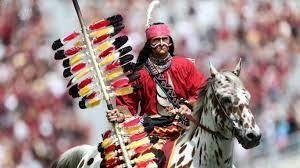

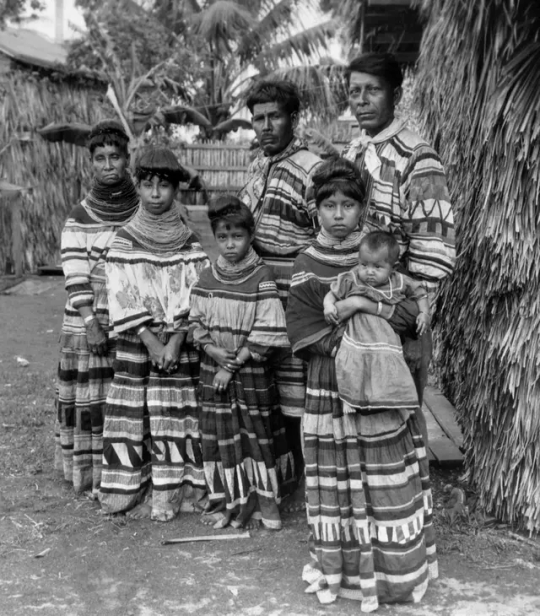
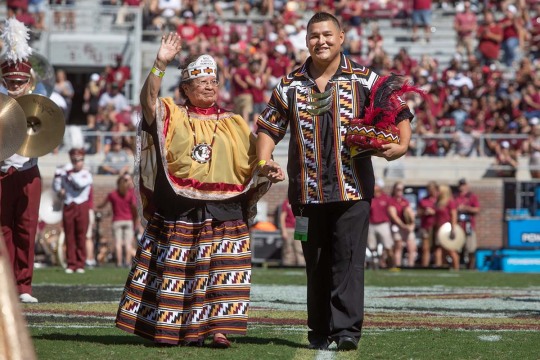
The Seminole are a Native American people who developed in Florida in the 18th century. Today, they live in Oklahoma and Florida, and comprise three federally recognized tribes: the Seminole Nation of Oklahoma, the Seminole Tribe of Florida, and the Miccosukee Tribe of Indians of Florida, as well as independent groups.
The word "Seminole" is almost certainly derived from the Creek word simanó-li. This has been variously translated as "frontiersman", "outcast", "runaway", "separatist", and similar words. The Creek word may be derived from the Spanish word cimarrón, meaning "runaway" or "wild one", historically used for certain Native American groups in Florida.

Native American refugees from northern wars, such as the Yuchi and Yamasee after the Yamasee War in South Carolina, migrated into Spanish Florida in the early 18th century. More arrived in the second half of the 18th century, as the Lower Creeks, part of the Muscogee people, began to migrate from several of their towns into Florida to evade the dominance of the Upper Creeks and pressure from encroaching colonists from the Province of Carolina. They spoke primarily Hitchiti, of which Mikasuki is a dialect. This is the primary traditional language spoken today by the Miccosukee in Florida. Joining them were several bands of Choctaw, many of whom were native to western Florida. Some Chickasaw had also left Georgia due to conflicts with colonists and their Native American allies. Also fleeing to Florida were African Americans who had escaped from slavery in the Southern Colonies
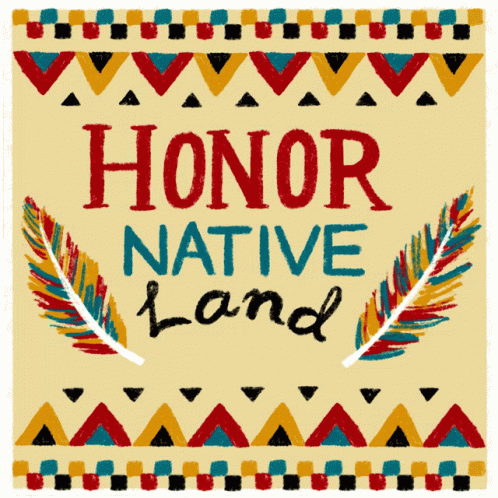
As they established themselves in northern and peninsular Florida throughout the 1700s, the various new arrivals intermingled with each other and with the few remaining indigenous people. In a process of ethnogenesis, they constructed a new culture which they called "Seminole", a derivative of the Mvskoke' (a Creek language) word simano-li, an adaptation of the Spanish cimarrón which means "wild" (in their case, "wild men"), or "runaway" [men].[ The Seminole were a heterogeneous tribe made up of mostly Lower Creeks from Georgia, who by the time of the Creek War (1813–1814) numbered about 4,000 in Florida. At that time, numerous refugees of the Red Sticks migrated south, adding about 2,000 people to the population. They were Creek-speaking Muscogee, and were the ancestors of most of the later Creek-speaking Seminole. In addition, a few hundred escaped African-American slaves (known as the Black Seminoles) had settled near the Seminole towns and, to a lesser extent, Native Americans from other tribes, and some white Americans. The unified Seminole spoke two languages: Creek and Mikasuki (mutually intelligible with its dialect Hitchiti), two among the Muskogean languages family. Creek became the dominant language for political and social discourse, so Mikasuki speakers learned it if participating in high-level negotiations. The Muskogean language group includes Choctaw and Chickasaw, associated with two other major Southeastern tribes.
In part due to the arrival of Native Americans from other cultures, the Seminole became increasingly independent of other Creek groups and established their own identity through ethnogenesis. They developed a thriving trade network by the time of the British and second Spanish periods (roughly 1767–1821). The tribe expanded considerably during this time, and was further supplemented from the late 18th century by escaped slaves from Southern plantations who settled near and paid tribute to Seminole towns. The latter became known as Black Seminoles, although they kept many facets of their own Gullah culture.
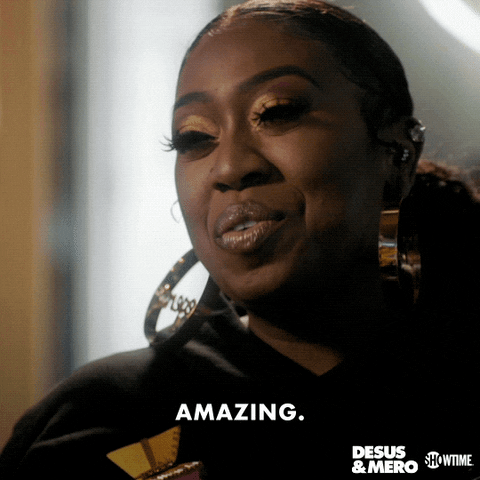
During the colonial years, the Seminole were on relatively good terms with both the Spanish and the British. In 1784, after the American Revolutionary War, Britain came to a settlement with Spain and transferred East and West Florida to it.
The Spanish Empire's decline enabled the Seminole to settle more deeply into Florida. They were led by a dynasty of chiefs of the Alachua chiefdom, founded in eastern Florida in the 18th century by Cowkeeper. Beginning in 1825, Micanopy was the principal chief of the unified Seminole, until his death in 1849, after removal to Indian Territory. This chiefly dynasty lasted past Removal, when the US forced the majority of Seminole to move from Florida to the Indian Territory (modern Oklahoma) after the Second Seminole War. Micanopy's sister's son, John Jumper, succeeded him in 1849 and, after his death in 1853, his brother Jim Jumper became principal chief. He was in power through the American Civil War, after which the U.S. government began to interfere with tribal government, supporting its own candidate for chief.
After raids by Anglo-American colonists on Seminole settlements in the mid-18th century, the Seminole retaliated by raiding the Southern Colonies (primarily Georgia), purportedly at the behest of the Spanish. The Seminoles also maintained a tradition of accepting escaped slaves from Southern plantations, infuriating planters in the American South by providing a route for their slaves to escape bondage.
After the United States achieved independence, the U.S. Army and local militia groups made increasingly frequent incursions into Spanish Florida to recapture escaped slaves living among the Seminole. American general Andrew Jackson's 1817–1818 campaign against the Seminoles became known as the First Seminole War. Though Spain decried the incursions into its territory, the United States effectively controlled the Florida panhandle after the war.


#african#afrakan#kemetic dreams#africans#brownskin#brown skin#afrakans#asians#asian#asian chick#asian babe#asian butt cheeks#asian beauty#asian cutie#asian babes#asian girl#asian girls#asian fashion#asian goddess#asian perfection#asian model#asian tattoos#asianbeauty#asian women#asianfemale#asiangirl#asianpeople#asiansexy#asianwomen#beautiful asian women
17 notes
·
View notes
Text

REMEMBER
Remember the sky that you were born under,
know each of the star’s stories.
Remember the moon, know who she is.
Remember the sun’s birth at dawn, that is the
strongest point of time. Remember sundown
and the giving away tonight.
Remember your birth, how your mother struggled
to give you form and breath. You are evidence of
her life, and her mother’s, and hers.
Remember your father. He is your life, also.
Remember the earth whose skin you are:
red earth, black earth, yellow earth, white earth
brown earth, we are earth.
Remember the plants, trees, animal life who all have their
tribes, their families, their histories, too. Talk to them,
listen to them. They are alive poems.
Remember the wind. Remember her voice. She knows the
origin of this universe.
Remember you are all people and all people
are you.
Remember you are this universe and this
universe is you.
Remember all is in motion, is growing, is you.
Remember language comes from this.
Remember the dance language is, that life is.
Remember.
by Joy Harjo *(Muscogee/Creek Nation, 3rd term US Poet Laureate)
Artist Sam Brown
The Heirloom Gardener John Forti
8 notes
·
View notes
Text
On This Day In History
January 27th, 1825: The Congress of the USA approves the Oklahoma Territory, resulting in the Trail of Tears as about 60,000 Native Americans (of the Aniyvwiyaʔi|Cherokee, Muscogee|Creek, Seminole, Chickasaw, and Choctaw nations) are forcibly moved to make way. Thousands died during or directly after.
#history#work history#usa history#american history#indigenous history#trail of tears#genocide#racism#violence
72 notes
·
View notes
Text
For Calling the Spirit Back from Wandering the Earth in Its Human Feet
by Joy Harjo
_________
Put down that bag of potato chips, that white bread, that bottle of pop.
Turn off that cellphone, computer, and remote control.
Open the door, then close it behind you.
Take a breath offered by friendly winds. They travel the earth gathering essences of plants to clean.
Give it back with gratitude.
If you sing it will give your spirit lift to fly to the stars’ ears and back.
Acknowledge this earth who has cared for you since you were a dream planting itself precisely within your parents’ desire.
Let your moccasin feet take you to the encampment of the guardians who have known you before time, who will be there after time. They sit before the fire that has been there without time.
Let the earth stabilize your postcolonial insecure jitters.
Be respectful of the small insects, birds and animal people who accompany you.
Ask their forgiveness for the harm we humans have brought down upon them.
Don’t worry.
The heart knows the way though there may be high-rises, interstates, checkpoints, armed soldiers, massacres, wars, and those who will despise you because they despise themselves.
The journey might take you a few hours, a day, a year, a few years, a hundred, a thousand or even more.
Watch your mind. Without training it might run away and leave your heart for the immense human feast set by the thieves of time.
Do not hold regrets.
When you find your way to the circle, to the fire kept burning by the keepers of your soul, you will be welcomed.
You must clean yourself with cedar, sage, or other healing plant.
Cut the ties you have to failure and shame.
Let go the pain you are holding in your mind, your shoulders, your heart, all the way to your feet. Let go the pain of your ancestors to make way for those who are heading in our direction.
Ask for forgiveness.
Call upon the help of those who love you. These helpers take many forms: animal, element, bird, angel, saint, stone, or ancestor.
Call your spirit back. It may be caught in corners and creases of shame, judgment, and human abuse.
You must call in a way that your spirit will want to return.
Speak to it as you would to a beloved child.
Welcome your spirit back from its wandering. It may return in pieces, in tatters. Gather them together. They will be happy to be found after being lost for so long.
Your spirit will need to sleep awhile after it is bathed and given clean clothes.
Now you can have a party. Invite everyone you know who loves and supports you. Keep room for those who have no place else to go.
Make a giveaway, and remember, keep the speeches short.
Then, you must do this: help the next person find their way through the dark.
______
Joy Harjo, internationally renowned poet and performer of the Muscogee (Creek) nation : https://www.joyharjo.com/

6 notes
·
View notes
Text
Government
the Muscogee (creek) nation, like most tribal nations, is an operating government within the US. Each tribe determines their own citizenship, creates their own laws, and regulate their own license among the citizens of the nation.
The current Muscogee constitution was voted on and approved in 1979. This replaced the original constitution in 1867.
The tribal government has three branches that mirror the United States constitution.
There is the Tvstvnvkvlke encuko (house of warriors) and the Mēkkvlke encuko (house of kings), which are two houses that make up the legislative branch. This national council is the lawmaking body of the muscogee nation. Sixteen individuals serve in this council.
There is an executive branch headed by the principal chief and second chief. Both are elected offices. David Hill is the current principal chief with Del Beaver operating as the second chief.
The national council elects the Supreme Court judges of the Muscogee nation.
The muscogee nation provides social services, a tribal police force, an accredited tribal college, manages seven tribal health clinics, two community hospitals, and a physical rehabilitation center within the Muscogee nation territory.
The nation is a federally recognized self-governing tribe. The nation consists of eight tribal congressional districts, making up 5,000 square miles across 11 counties in Oklahoma.
Okmulgee, Oklahoma is the capital of the Muscogee nation. It has been the capital since 1868. The name comes from the Ocmulgee mound builder site in Macon, Georgia. This historic site is believed to be the first settlement of the Muscogee people and can be visited today. Many Muscogee people visit this site, and it's very beautiful from what I hear.

#native blogs#muscogee#indigenous blog#indigenous#native american#mvskoke#muskogee#indigenous history
3 notes
·
View notes
Text

It wasn't "like" the Trail of Tears - IT WAS THE TRAIL OF TEARS. The Muscogee (Creek) nation was forcibly relocated to Oklahoma during the Removal Act, alongside the Cherokee, Seminole, Chickasaw, and Choctaw. There is literally a Trail of Tears monument in the same park as the Council Oak Tree.
#house of zoey#redeemed#rage from a native studies major#i do more research for this blog than the authors did for their book
8 notes
·
View notes